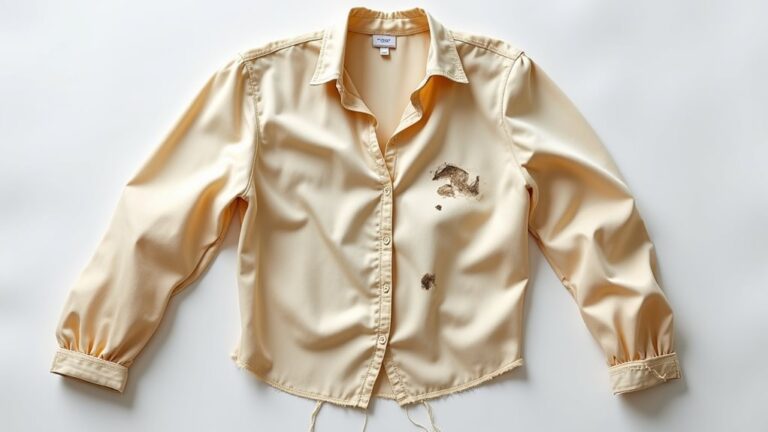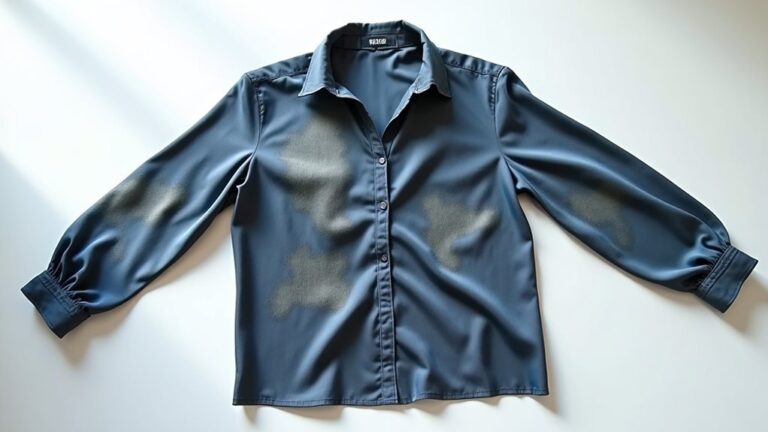Dry cleaning’s genuinely excellent for delicate fabrics like wool suits, silk blouses, and cashmere sweaters since it uses solvents instead of water, preventing shrinkage while tackling oil-based stains your washing machine can’t handle. You’ll find it maintains garment structure, extends clothing lifespan, and protects embellished pieces from damage. However, it’s costly, less effective on water-based stains, and not necessary for everyday cotton items. Understanding which pieces truly benefit will help you make smarter decisions about this specialized service.
What Makes Dry Cleaning Different From Regular Washing
When I first started taking my favorite silk blouse to the dry cleaner instead of tossing it in the washing machine with everything else, I honestly didn’t understand what made the process so special—until I learned that dry cleaning doesn’t actually use water at all.
The dry cleaning process relies on a liquid cleaning solvent called perchloroethylene that’s incredibly effective at tackling oil-based stains your regular laundry simply can’t handle.
This cleaning method protects delicate fabrics like wool and cashmere from the swelling and shrinking that water causes, while the specialized machines gently agitate your clothes and recover 99.99% of the solvent for reuse—making it surprisingly environmentally friendly.
It removes stubborn stains while preserving your garment’s original texture and color. 😊
However, it’s worth noting that perchloroethylene has been classified as a probable human carcinogen by health authorities, which is why many dry cleaners are transitioning to safer alternatives.
Which Fabrics and Garments Benefit Most From Dry Cleaning

Understanding how dry cleaning works is only half the battle—knowing which pieces in your closet actually need this special treatment will save you both money and heartache down the road.
Your delicate wool sweaters, silk blouses, and luxurious cashmere scarves absolutely thrive with dry cleaning, which removes stubborn stains while preserving their precious fibers from shrinkage disasters I’ve witnessed too many times 😅.
Garments with sequins, lace, or intricate buttons require this gentle approach, as regular washing can transform your favorite pieces into tragic casualties.
Pleated skirts and dresses maintain their crisp structure through dry cleaning, while lined jackets keep their customized fit.
Don’t forget household fabrics like curtains and duvets—they benefit tremendously from this specialized care.
The chemical solvents used in dry cleaning effectively remove dirt and stains without the water damage that can cause color bleeding in synthetic blends and other delicate materials.
The Professional Process Behind Effective Dry Cleaning
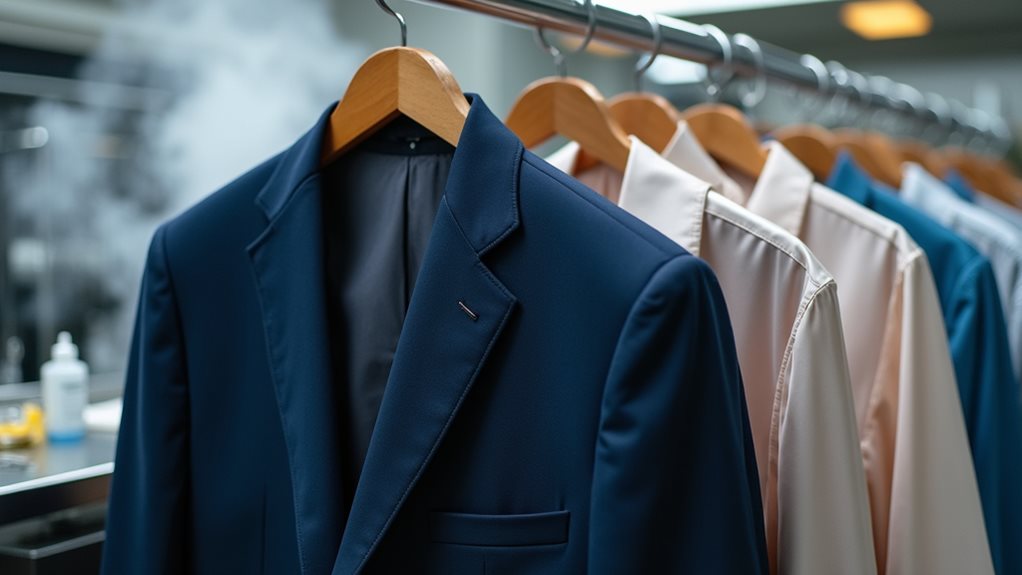
Behind the scenes at your local dry cleaner, a surprisingly intricate dance unfolds that transforms your beloved garments from stained disasters back to pristine condition through careful precision and professional expertise.
The dry cleaning process starts with tagging and detailed inspections, where skilled technicians become detective-like, hunting down every stubborn stain that threatens your favorite silk blouse. They’ll pre-treat each spot with specialized solutions before your garments enter specialized machines filled with organic solvent instead of water.
This gentle cleaning cycle protects delicate fabrics while lifting away dirt and grime. The most common solvent used is perchloroethylene, though many cleaners are now switching to newer eco-friendly alternatives that are safer for both the environment and workers. After another round of inspections, pressing and steaming complete the transformation.
This meticulous approach doesn’t just clean—it’ll extend lifespan considerably, keeping your wardrobe looking fresh for years.
Key Advantages That Make Dry Cleaning Worth It
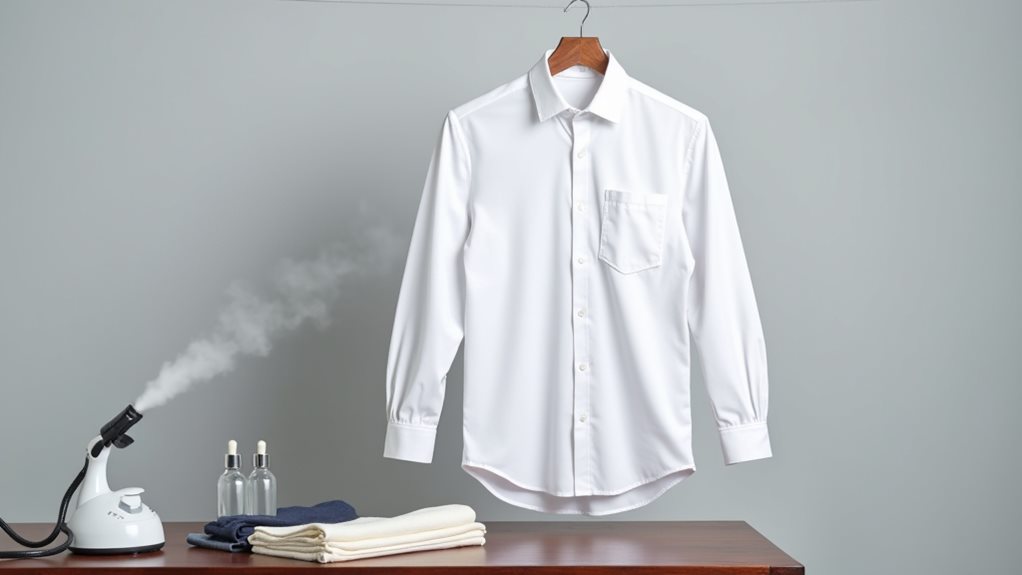
You’ve probably wondered if dry cleaning‘s worth the extra cost, especially when your favorite silk blouse gets hit with that mysterious salad dressing stain that laughs at your regular detergent 😅.
The truth is, dry cleaning offers three game-changing advantages that can save both your wardrobe and your sanity: it protects those delicate fabrics you’re afraid to wash at home, tackles stubborn stains that would otherwise become permanent reminders of clumsy moments, and extends your garments’ lifespan so you’re not constantly replacing expensive pieces.
Unlike traditional washing methods, dry cleaning uses chemical solvents instead of water, which makes it particularly effective for removing oil-based stains while preventing the shrinkage and color bleeding that can ruin your most treasured garments.
When you understand these benefits, you’ll see why professional cleaning isn’t just a luxury, but often the smartest investment for maintaining your clothing collection.
Protects Delicate Fabrics
When you’ve invested in that gorgeous silk blouse or luxurious cashmere sweater, the last thing you want is to watch it transform into a shrunken, faded shadow of its former self after one ill-fated trip through your washing machine.
That’s where dry cleaning becomes your delicate fabrics‘ best friend, using organic solvents instead of water to prevent the fiber swelling that ruins your favorite pieces.
The cleaning process gently removes dirt without causing shrinkage or color bleeding, while specialized stain removal techniques tackle stubborn oil-based stains that regular washing can’t handle.
Your sequined dress and lace blouse will maintain their softness and intricate details, guaranteeing longevity that makes every dollar spent worthwhile.
Garments with special construction features like structured blazers with interfacing or beaded items require professional dry cleaning to preserve their shape and prevent damage from the agitation and heat of conventional washing methods.
Removes Stubborn Stains
While water-based washing might handle your everyday spills and dirt, it’s absolutely powerless against those sneaky oil-based stains that seem to mock your best cleaning efforts from deep within the fabric fibers.
This is where dry cleaning involves using a chemical solvent that actually removes stubborn marks your washing machine can’t touch.
Professional dry cleaners have mastered the art of stain removal, wielding specialized pre-treatment solutions like tiny warriors against grease, makeup, and mystery spots you can’t even identify anymore 😅.
The efficiency of organic solvents means they penetrate deeper than water ever could, especially on delicate items that would surrender to aggressive scrubbing.
Your garments emerge restored to their original brightness, finally free from those ground-in battles.
Beyond stain removal, dry cleaning also helps preserve the shape and texture of your garments while preventing the shrinkage and fading that often occurs with regular washing.
Extends Garment Lifespan
Since your favorite blazer costs more than your monthly coffee budget, protecting that investment becomes surprisingly personal.
Dry cleaning offers the kind of gentle care that keeps expensive garments looking fresh for years rather than months.
Professional dry cleaning extends the life of your wardrobe through three essential methods:
- Fiber preservation – Organic solvents maintain the integrity of fibers without causing swelling or shrinkage.
- Pest prevention – Removes oils and stains that attract moths and other fabric-damaging insects.
- Shape retention – Delicate fabrics like silk and wool maintain their original fit and drape.
The process is particularly effective at removing oil-based stains that traditional washing methods often leave behind, ensuring your garments stay pristine.
When you consider that quality garments represent a notable investment over time, dry cleaning becomes less about expense and more about protecting what you’ve already spent on pieces you genuinely love wearing.
Potential Drawbacks and Limitations to Consider
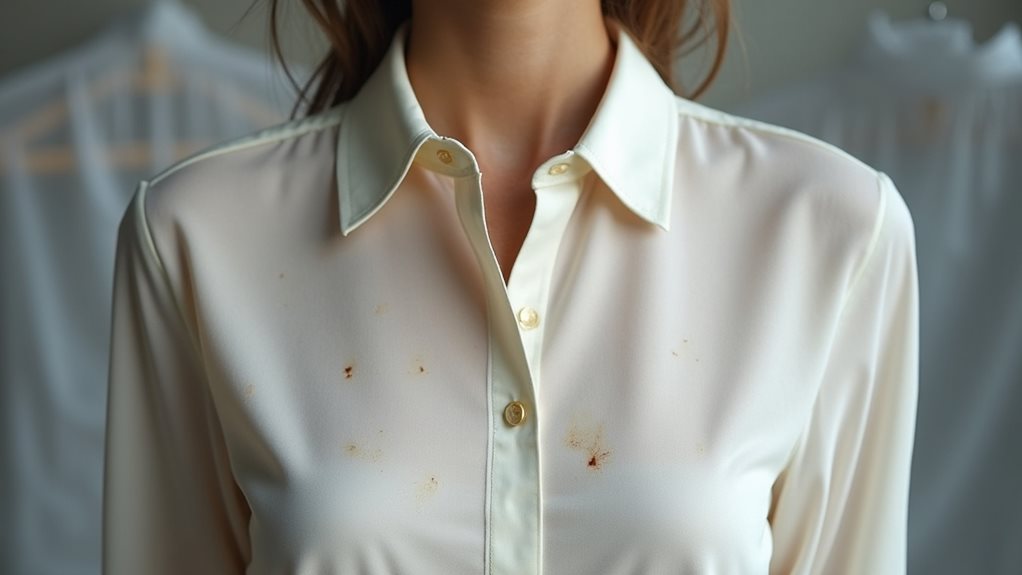
Although dry cleaning offers impressive benefits for delicate garments, you’ll want to understand its limitations before making it your go-to cleaning method.
These cleaning uses come with real drawbacks that’ll affect your wallet and wardrobe decisions. Water-based stains, ironically, don’t respond well to dry cleaning services, so that coffee spill might stick around despite professional treatment.
You’ll also face health and environmental risks from traditional solvents, which concern many eco-conscious consumers today. Cost becomes another factor, with stubborn stains requiring multiple visits that add up quickly.
Always check your care label first—some fabrics actually get damaged by dry cleaning solvents! Plus, improper handling at subpar facilities can ruin your favorite pieces, making these important limitations to evaluate. The chemicals used can potentially cause color fading or leave behind unpleasant odors that may irritate sensitive individuals.
Getting Maximum Value From Your Dry Cleaning Service

You’ll get the most bang for your buck when you’re strategic about what goes to the dry cleaner, focusing on items that truly need professional care like wool suits, silk blouses, and garments with “dry clean only” labels rather than tossing in everything from your hamper.
When you drop off clothes with stains, don’t just point vaguely and mumble “there’s something on it” – be specific about what caused the stain, whether it’s red wine from last night’s dinner party or that mysterious grease spot from your car troubles, because your cleaner becomes a stain detective with the right clues.
I learned this lesson the hard way when my favorite dress came back with a stubborn coffee stain still intact, simply because I forgot to mention it was actually chocolate sauce that had hardened overnight 😅.
Professional dry cleaning becomes particularly valuable for structured clothing like blazers and formal wear that would lose their shape in a regular washing machine, preserving the tailored construction that gives these garments their polished appearance.
Choose Right Items
When I first started taking my clothes to the dry cleaner, I’d basically dump everything in my laundry basket and hope for the best – which, as you might imagine, led to some expensive mistakes and a few fashion disasters that still make me cringe.
Now I know that choosing the right items for dry cleaning is essential for getting your money’s worth.
Here’s what you should prioritize for the recommended method of cleaning:
- Delicate fabrics like silk, wool, and cashmere that can’t handle regular washing
- Garments with embellishments such as beaded dresses or sequined tops that need gentle care
- Pleated fabrics and structured pieces that need to maintain shape
Don’t forget household items like curtains and rugs – dry cleaning can effectively remove stains while extending their lifespan.
The key is learning to read care labels properly, as they’ll tell you definitively whether an item requires professional dry cleaning or can be safely washed at home.
Communicate Stain Details
Once you’ve identified the perfect candidates for professional cleaning, the real magic happens in how you communicate with your dry cleaner about those pesky stains that seem to have a personal vendetta against your favorite clothes.
Think of yourself as a detective presenting evidence – the more details you provide about those stubborn stains, the better your dry cleaners can work their removal wizardry.
Tell them exactly what caused each mark (was it oil-based salad dressing or red wine?), when it happened, and honestly confess any home treatment attempts you’ve made.
Don’t forget to mention delicate embellishments like beading or lace, and consider pointing out problem areas on your garments – this communication transforms the entire cleaning process from guesswork into precision care.



